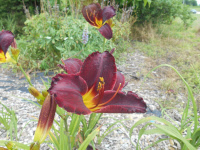Description
Tetraploid daylily with slightly ruffled maroon petals with a bright yellow center.
Slightly ruffled maroon petals with a bright yellow center
Tetraploid daylily with slightly ruffled maroon petals with a bright yellow center.
Small purple flowers atop tall leafless stems from July to October. Great see-through blooms for growing in back, middle or front of the garden.
Size: 3-4’ x 8”
Care: full sun in moist, well-drained, fertile soil - self-seeder
Native: South America
Awards: Royal Horticultural Society Award of Merit & Missouri Botanic Garden Plant of Merit.
Introduced to garden cultivation from its native Buenos Aires in 1726 by the Sherard brothers.
Fast-growing, pyramidal-shaped deciduous conifer. The orange to brown trunk base tapers and thickens with up to a dozen large buttress-like root flares extending several feet up the trunk. Feathery, fern-like, soft foliage emerges light green in spring, and turns red-bronze in fall before dropping. Its branches are well-attached and make excellent climbing.
Size: 70-90’ x 15-25’
Care: sun in moist to moist well-drained, slightly acid soil
Native: Szechuan China
Awards: Royal Botanic Garden Award of Garden Merit, Yew Dell Botanical Gardens’ Theodore Klein Plant Awards & Pennsylvania Horticultural Society Gold
From fossil records, dawn redwood is known to have existed as many as 50,000,000 years ago. However, it was not until 1941 that dawn redwood was first discovered growing in the wild near the town of Modaoqi China by Chinese forester, T. Kan. Seeds collected from the original site were made available to the Missouri Botanical Garden in 1947. Seedlings grown therefrom were planted in front of the Lehmann Building at MBG in 1952 where they have now developed into large mature trees (70’+ tall). Dawn redwood is a deciduous, coniferous tree that grows in a conical shape to 100’ tall. It is related to and closely resembles bald cypress (Taxodium) and redwood (Sequoia).
OUT OF STOCK
Lavender-Pink outside and white inside funnels in June
Size: 20” x 12-24”
Care: sun in well-drained soil
Native: northeast North America
Wildlife Value: attracts Baltimore butterfly and feeds the Rusty patched Bumble Bee
Penstemon is named for its five stamens, penta meaning “five” and stemon meaning “stamen” in Greek. Penstemons are “handsome and deserving,” Bailey. P. hirsutus sent from America to England in 1758.
Purple, upfacing bells for months in mid to late summer
Size: 4-6” x 20”
Care: full sun-part shade in moist well-drained soil
Native: Northern Yugoslavia
Awards: England’s Royal Horticultural Society Award of Merit. Top rated Chicago Botanic Garden & Elisabeth Carey Miller Botanical Garden Great Plant Pick.
Campanula is Latin meaning “little bell.” 1st described in Systema Vegetabilium 5: 93 in 1819 by one of its discoverers, Franz Edler von Portenschlag-Ledermayer (1772-1822).

